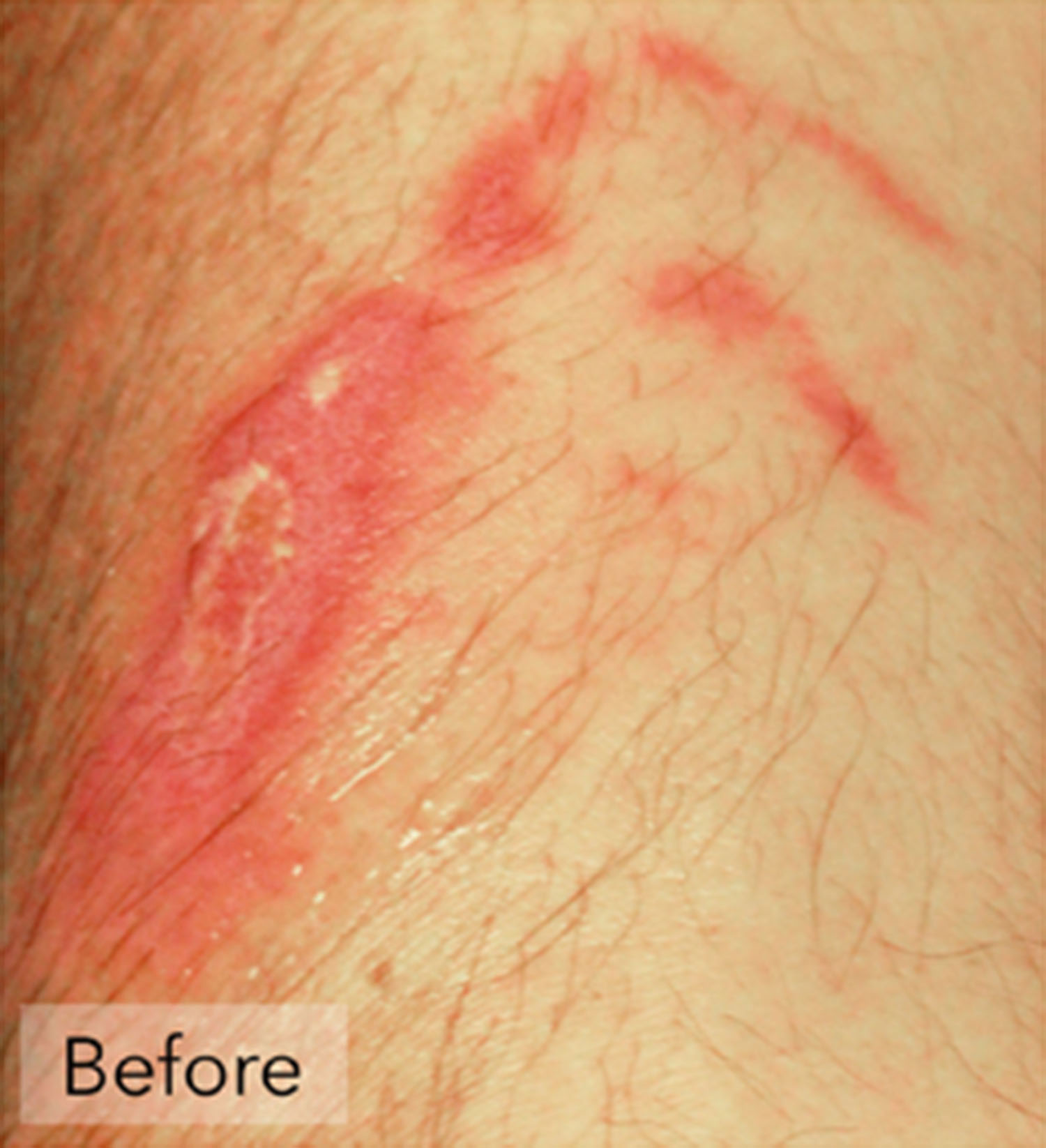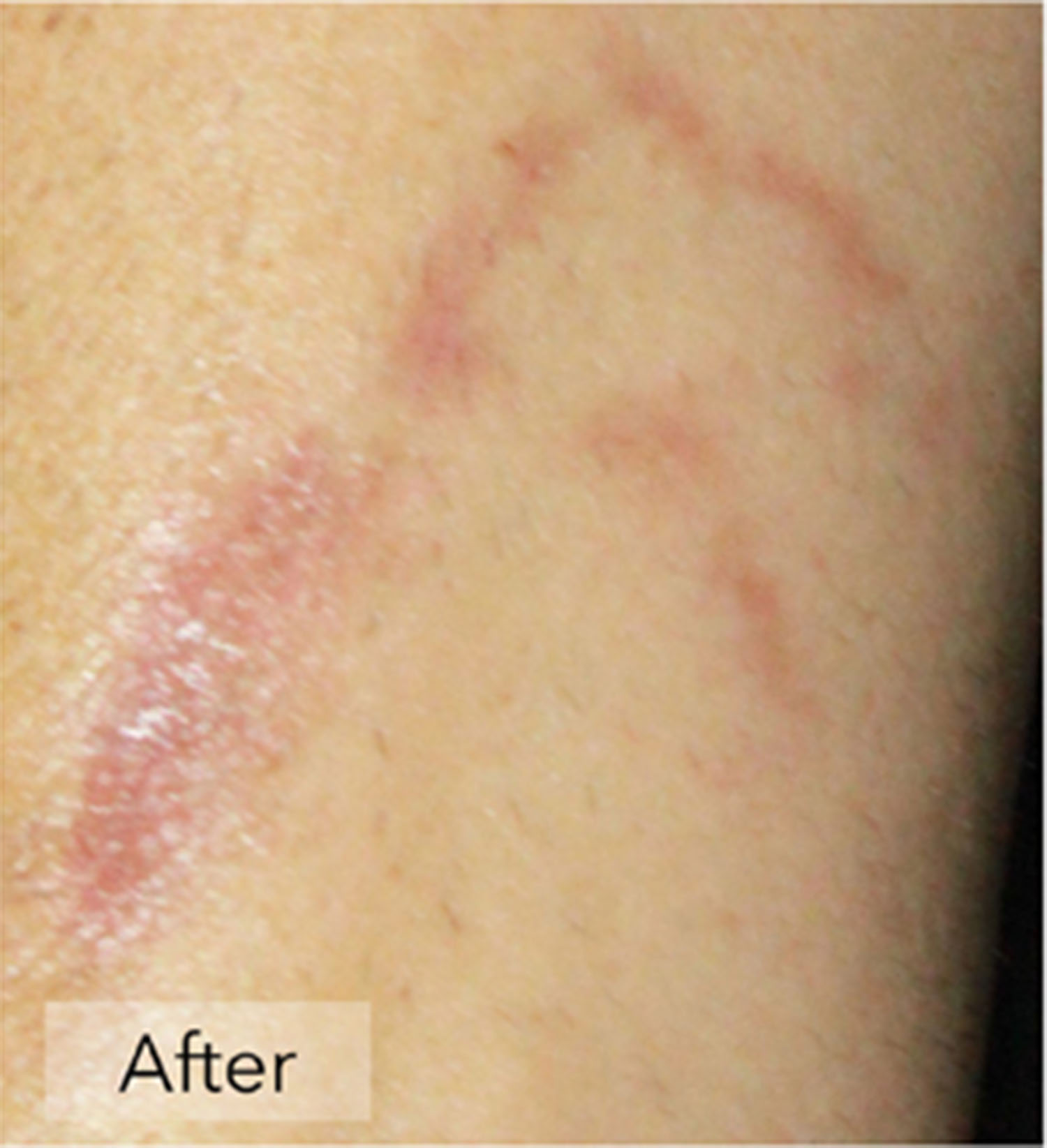Medical Dermatology
Scars
Scar Treatments
Make Lasting Marks Less Noticeable in the Dallas Area
 Scars are marks left on the skin as it repairs wounds caused by accidents, diseases (such as acne), or surgery. They are a natural part of the healing process, but they are also often an unwanted reminder of injury or other trauma. With scar treatments, the Dallas and Irving-based team at the Dermatology Office can minimize the appearance of lasting marks, making them more difficult to see.
Scars are marks left on the skin as it repairs wounds caused by accidents, diseases (such as acne), or surgery. They are a natural part of the healing process, but they are also often an unwanted reminder of injury or other trauma. With scar treatments, the Dallas and Irving-based team at the Dermatology Office can minimize the appearance of lasting marks, making them more difficult to see.
The more the skin is damaged and the longer it takes to heal, the greater the chance of a noticeable blemish on the surface. Typically, scars may appear red and thick at first, and then gradually fade to a color that more closely resembles the surrounding tissue. Many actively healing scars that seem unsightly at three months may heal nicely if given more time. Others remain highly visible—and may even be noticeably raised or depressed.
Medical Dermatology
For more details about prevention and treatment for scars at our Dallas or Irving locations, book an appointment online or call (214) 373-7546 to schedule an appointment.
The way a scar forms is influenced by an individual’s age and the location of the trauma on the body or face. Younger skin makes strong repairs and tends to “over heal,” resulting in larger, thicker spots on the skin. Skin over a jawbone is tighter than skin on the cheek and will make the scarring easier to see. If the spot is indented or raised, irregular shadows will be seen in certain light conditions, giving the skin an uneven appearance. A scar that crosses natural expression lines or is wider than a wrinkle will be more apparent because it will not follow a natural pattern, nor look like a naturally occurring line.
Any one of these factors—or a combination of them—may result in a scar that could be improved by treatment. Scars can sometimes improve on their own, but there are several techniques that can minimize the mark. Most of these are performed routinely by licensed dermatologists, such as Dr. Ellen Turner, who offers scar treatments as part of the general dermatology services at her practice.
Only severe scarring, such as burns over a large part of the body, may require general anesthesia or a hospital stay as part of the repair process. The most important step in scar treatment is careful consultation between the patient and the dermatologist, finding out what bothers a patient most about the marks, and deciding upon the best options for treatment.
Scar Treatments
Laser Resurfacing and Laser Scar Revision
One method of improving surgical, acne, hyperpigmentation, injury, burn, chicken pox, and other scars is laser scar revision. High-energy light is used to remove or remodel unwanted, damaged skin. Patients can usually return to work or regular activity within one week, but skin may stay pink for several weeks or months, particularly after skin resurfacing with a carbon dioxide (CO2) laser. Several different lasers are available depending on the skin defect requiring improvement.
Marks that are left from acne breakouts or other indented (atrophic) scars can be improved with laser skin resurfacing such as Halo® by Sciton. Hypertrophic (thick, raised) scars or keloids typically need two or more pulsed dye laser treatments. Certified laser technicians at the Dermatology Office may also use radiofrequency microneedling such as Secret® by Cutera or a picosecond laser depending on the color of the scar. Sun protection will be critical before and after any kind of laser-based treatment as there is a higher risk of a serious burn or discoloration if you arrive for your treatment with a tan or sunburn.
Soft Tissue Fillers (Juvéderm®, Restylane®, Hyaluronic Acid or Fat Injections)
Various injectable fillers are available to elevate indented, soft patches of skin. The amount of material injected will vary with the size and firmness of the mark. Improvement will be seen right away, but is temporary, and injections often need to be repeated. The patients’ own fat or injectable donated fascia can be used in full-thickness, deep, depressed marks. Dr. Turner will discuss the available dermal fillers and help you decide which is best for you. Research is continuing to develop more long-standing substances to inject into these skin lesions.
Punch Grafts and Punch Excision
Punch grafts are small pieces of healthy skin used to replace scarred skin. A tiny circular “cookie cutter” is used to cut a hole in the skin and remove the lesion. The area is then filled in with a matching piece of unscarred skin, usually taken from the area behind the ear, where its removal will not be easily noticed. The “plugs” are taped into place for five to seven days as they heal.
Punch excisions, on the other hand, involve the use of stitches to close the holes produced by the tiny skin punch. The stitches are removed in five to seven days. Even though the punch grafts and excisions form scars of their own, they provide a smoother skin surface, which is less visible than depressed lesions. Deep or “pitted” acne marks are best treated by punch grafts or excisions.
Dermatology Office
Meet Dr. Ellen Turner
Dr. Ellen Turner and her staff at the Dermatology Office strive to work within a space where compassion meets technology to obtain top results for Dallas patients.


Steroid Injections
Cortisone (steroid) injections or tape are effective in softening very firm skin lesions (or keloids), causing the typically raised marks to shrink and flatten. This treatment is popular (along with pulsed dye laser) for hypertrophic scars and keloids. Steroids are injected directly into the tissue to reduce itching, swelling, or burning, while also minimizing the skin irregularity.
Surgical Revision
Based on the ability of the skin to stretch with time, surgical scar revision is a method of removing a scar and rejoining the normal skin in a less obvious fashion. The surgical removal of scars is best suited for wide or long blemishes on the skin, marks in prominent places, or lesions that have healed in a particularly noticeable pattern or shape.
Wide scars can often be cut out and closed, resulting in a thinner scar, and long scars can be made shorter. A technique of irregular or staggered incision lines, rather than straight-line incisions, may be used to develop a broken-line scar, which makes it much more difficult to recognize. Sometimes, the mark’s direction can be changed so that all or part of the scar that crosses a natural wrinkle or line falls into the wrinkle, making it less noticeable. This method can also be used to move skin irregularities into more favorable locations, such as into the hairline or a natural junction (for instance, where the nose meets the cheek). The best results are obtained when the lesion is removed and the wound’s edges are brought together without tension or movement (pull) on the skin.
Dr. Turner prides herself on outstanding patient care. She is very diligent about listening to concerns and choosing appropriate therapies for each patient. You can expect your consultation with her to be comfortable, informative, and respectful.
How Much Does Scar Treatment Cost?
Cost of scar treatments will vary based on the type and extent of procedure recommended by Dr. Turner. The cost of the treatment will also depend on the type, size, and the number of scars. Some patients may need multiple treatment sessions to maximize results, which may also affect costs.



